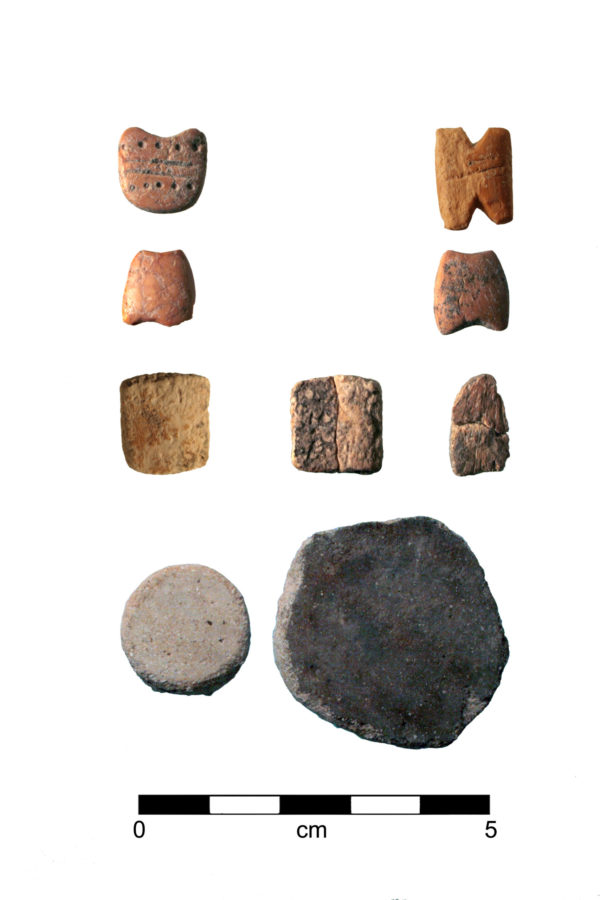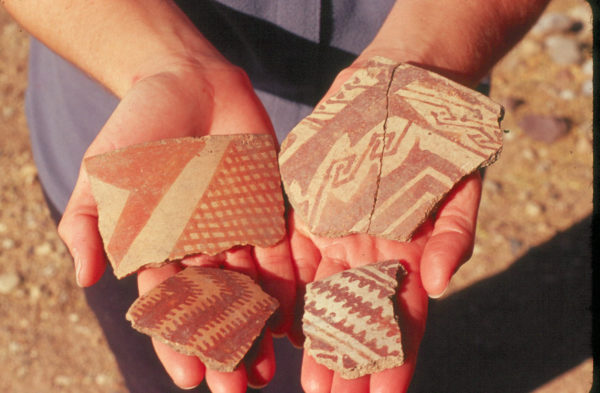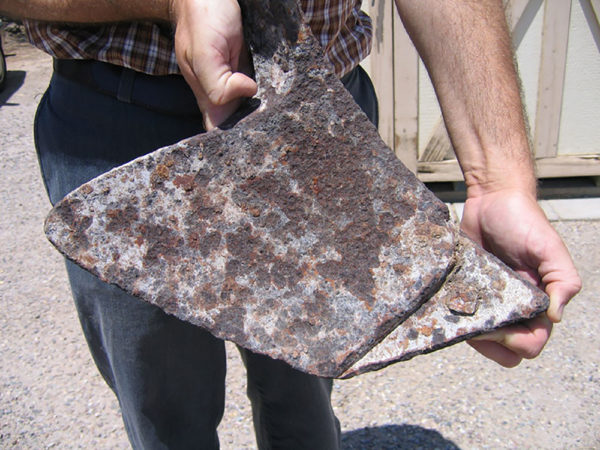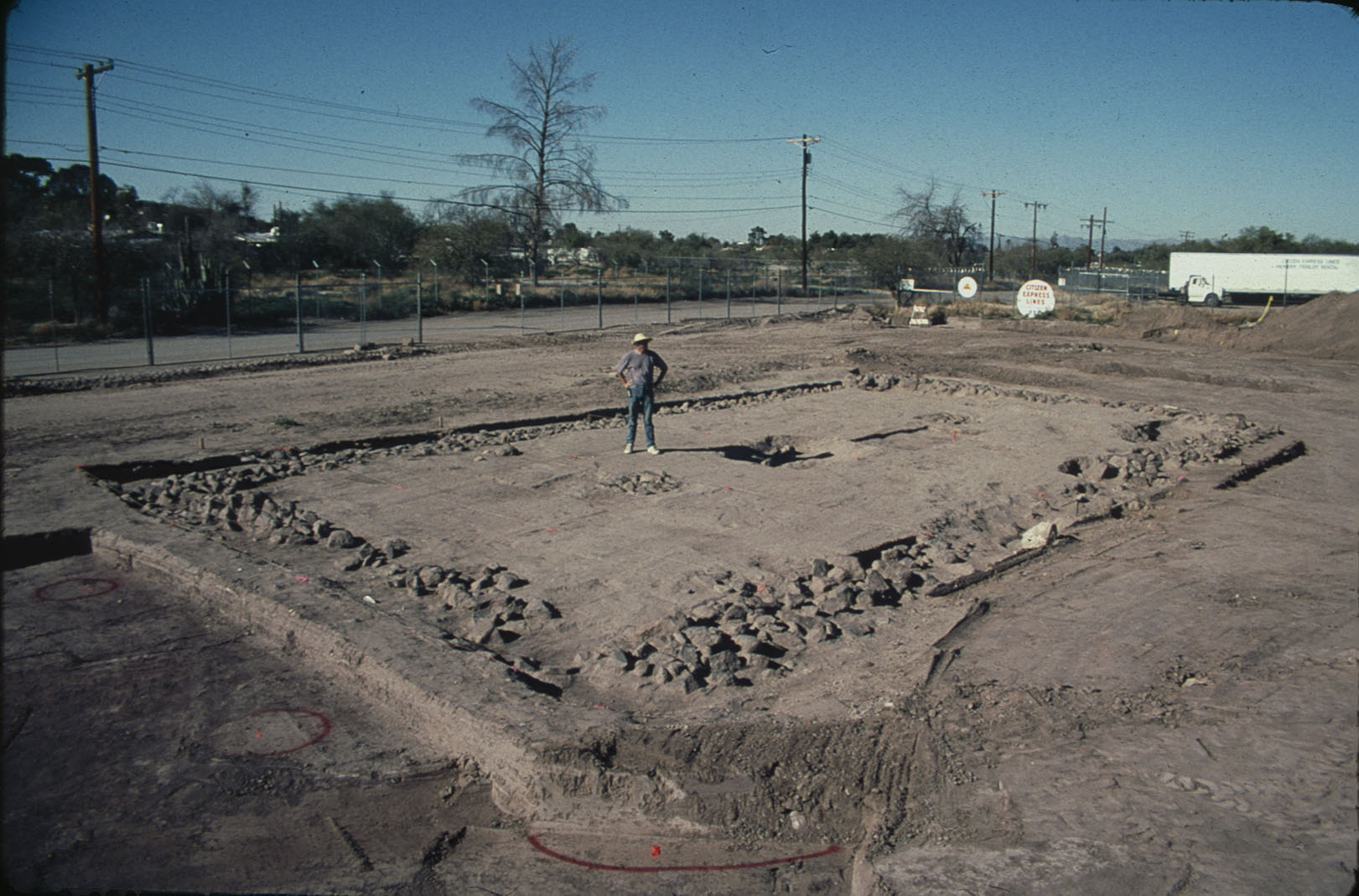
2,000 Years of Human History at Mission Garden
For the last ten years, visitors to the Mission Garden, located at the base of Sentinel Peak (“A” Mountain) have watched as fruit trees grow from saplings into tall trees, seen an acequia (canal) built and stocked with an endangered species, viewed crops being harvested and food preparation methods demonstrated. Desert Archaeology conducted archaeological work prior to the Garden’s construction.
The first phase was exploratory. Archaeologists uncovered the foundations of the west and south walls of the Garden, cleaning around the rocks by hand. Then the backhoe dug a series of east-to-west trenches. The crew scraped the walls of the trench and documented the features that were visible. The work provided enough data to accurately reconstruct the Garden walls.
The second phase of work targeted areas where construction was planned. We uncovered the north foundation of the Mission Garden, excavating strip trenches where the new wall foundations were to be built, offset from the original foundations to preserve them in place. Other strip trenches were placed where tree plantings and a canal were planned.
What did we find?
Early Agricultural Period (800 BC-AD 50)
This time period saw farmers growing maize (corn) on the Santa Cruz River floodplain, irrigating small field plots and living nearby in round pit structures. The nearby Mission Locus of the Clearwater site had many pit structures from this period. In contrast, we only found only two Early Agricultural period pit structures in the Garden, perhaps because others were far below the modern ground level. One was a dwelling. The other was probably a small ceremonial structure. It was 4.5 m (14.75 feet) in diameter, had a fire-reddened hearth in the center, and a large grinding slab nearby. Of particular interest was an upright stone column standing on the floor near the east side of the house. A similar ceremonial house was previously encountered at the top of nearby Tumamoc Hill, also with an upright column. The function of these columns is not known. Perhaps they were tapped to make sounds or perhaps they were once covered with some perishable materials.
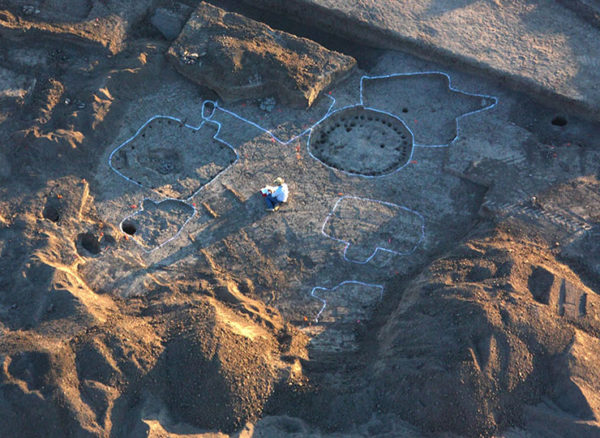
Archaeologist Homer Thiel documenting some of the Early Ceramic structures (and one Early Agricultural period structure) in the Garden (photo by Henry Wallace).

Allen Denoyer draws a map of the probable ceremonial house. The stone column is to the left of Allen (photo by Homer Thiel).
Early Ceramic period (AD. 50-500)
People began to use pottery–first for storage and then for cooking–during this period. They also experimented with architecture. Instead of round houses, people built bean-shaped, oval, sub-rectangular, and square houses. One of the houses here apparently was used for storage. Five large seed jars, all crushed, were located on the floor. In another house, we found a set of gaming pieces made from animal bone and pottery . These were likely used in some sort of gambling game. Similar pieces have been found at sites in northern Arizona.
Hohokam era (AD. 500-1300)
There were numerous Hohokam houses scattered throughout the Garden, but historic era plowing had damaged many, often leaving only the hearth intact. Numerous pieces of decorated pottery were present in the plow zone, most dating between AD 1140 and 1300. In the 1950s George Cattanach documented additional evidence for the village to the east and south, but this area unfortunately was destroyed by the City of Tucson landfill that operated there between 1956 and 1960. We also found irrigation canals in the Garden, running in a northerly direction and originating from the Santa Cruz River. One canal was 7.58 m (24.9 feet) wide and 2.20 m (7.2 feet) deep, the largest Hohokam canal found so far in the Tucson Basin.
Spanish-Mexican Period (AD 1694-1856)
Father Eusebio Kino visited the O’odham village of S-cuk son in the 1690s. The name of the village in O’odham meant “at the base of the black” referring to the dark color of the rocks on the adjacent small mountain. The Spaniards transliterated the village name into Tucson. In the late 1790s, Spanish workers completed the San Xavier church and apparently moved north to construct the San Agustín Mission, located about 400 feet to the east of the Garden. They may have also constructed the Mission Garden walls. They dug a shallow trench where they stacked rocks from the nearby mountain to build foundations that were between 2.5 and 3 feet wide. Photographs reveal that adobe brick walls were built on top of them. We found a series of buttresses spaced 39 to 52 feet apart that helped hold the walls up. Pillars for a granary were found along the center of the 418-ft-long east wall, but it is uncertain whether it was ever completed. We found a few shallow irrigation canals that brought water into the walled Garden. Peaches and quince were probably grown in the Garden, as well as vegetables and grains. During times when the Apache raided the area, villagers could herd their cattle, sheep, horses, and mules inside the walls to protect their livestock.
Territorial Period (AD 1856-1912)
The earliest photograph of Mission Garden was taken in April 1880 by Carleton Watkins, a San Francisco photographer who set his stereoscope camera up on the side of Sentinel Peak. The adobe walls of the Garden are visible, as are structures built onto the east and north walls. We uncovered the remnants of each building. The house on the east side appears to have been occupied from the 1870s onward. A well was found to the west of the house, but we left that for some future archaeologist to investigate.
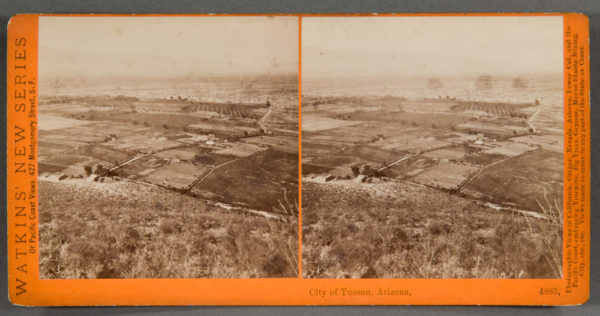
The Carleton Watkins stereoscopic photograph taken in April 1880. The Mission Garden is visible in the foreground, with the Convento structure for the San Agustin Mission.
Statehood Period (AD 1912-present)
The Garden continued to be used by Chinese and Mexican farmers into the 1930s. Afterward, several homes were built in there, used into the 1970s and 1980s.
Construction of the recreated Mission Garden began in 2008. After completion the Garden sat empty for several years until the non-profit Friends of Tucson’s Birthplace entered into an agreement with Pima County to operate the Garden in 2011. Since that time, the Friends have added irrigation systems, a heritage fruit tree orchard, Time-Line gardens, a Tarahumara Granary, a chicken coop, an education building, a kitchen, and an acequia. Recently, endangered Gila topminnows were placed in the acequia. Much of this work was funded by grants, donations, and by the Rio Nuevo tax increment finance district. The Mission Garden has an extensive volunteer program and many events, classes, and workshops which can be accessed through their website.
Resources
The first Rio Nuevo archaeology report, which includes the initial fieldwork for Mission Garden, is available online as a free PDF.


